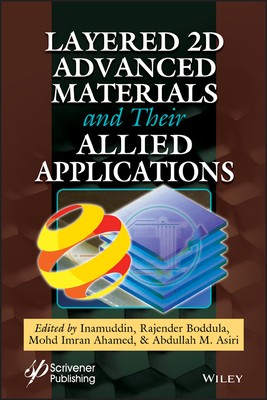
- We will send in 10–14 business days.
- Publisher: Wiley-Scrivener
- ISBN-10: 1119654963
- ISBN-13: 9781119654964
- Format: 15.2 x 22.9 x 2.2 cm, kieti viršeliai
- Language: English
- SAVE -10% with code: EXTRA
Layered 2D Materials and Their Allied Applications (e-book) (used book) | bookbook.eu
Reviews
Description
Ever since the discovery of graphene, two-dimensional layered materials (2DLMs) have been the central tool of the materials research community. The reason behind their importance is their superlative and unique electronic, optical, physical, chemical and mechanical properties in layered form rather than in bulk form. The 2DLMs have been applied to electronics, catalysis, energy, environment, and biomedical applications.
The following topics are discussed in the book's fifteen chapters:
- The research status of the 2D metal-organic frameworks and the different techniques used to synthesize them.
- 2D black phosphorus (BP) and its practical application in various fields.
- Reviews the synthesis methods of MXenes and provides a detailed discussion of their structural characterization and physical, electrochemical and optical properties, as well as applications in catalysis, energy storage, environmental management, biomedicine, and gas sensing.
- The carbon-based materials and their potential applications via the photocatalytic process using visible light irradiation.
- 2D materials like graphene, TMDCs, few-layer phosphorene, MXene in layered form and their heterostructures.
- The structure and applications of 2D perovskites.
- The physical parameters of pristine layered materials, ZnO, transition metal dichalcogenides, and heterostructures of layered materials are discussed.
- The coupling of graphitic carbon nitride with various metal sulfides and oxides to form efficient heterojunction for water purification.
- The structural features, synthetic methods, properties, and different applications and properties of 2D zeolites.
- The methods for synthesizing 2D hollow nanostructures are featured and their structural aspects and potential in medical and non-medical applications.
- The characteristics and structural aspects of 2D layered double hydroxides (LDHs) and the various synthesis methods and role of LDH in non-medical applications as adsorbent, sensor, catalyst, etc.
- The synthesis of graphene-based 2D layered materials synthesized by using top-down and bottom-up approaches where the main emphasis is on the hot-filament thermal chemical vapor deposition (HFTCVD) method.
- The different properties of 2D h-BN and borophene and the various methods being used for the synthesis of 2D h-BN, along with their growth mechanism and transfer techniques.
- The physical properties and current progress of various transition metal dichalcogenides (TMDC) based on photoactive materials for photoelectrochemical (PEC) hydrogen evolution reaction.
- The state-of-the-art of 2D layered materials and associated devices, such as electronic, biosensing, optoelectronic, and energy storage applications.
EXTRA 10 % discount with code: EXTRA
The promotion ends in 22d.03:06:25
The discount code is valid when purchasing from 10 €. Discounts do not stack.
- Publisher: Wiley-Scrivener
- ISBN-10: 1119654963
- ISBN-13: 9781119654964
- Format: 15.2 x 22.9 x 2.2 cm, kieti viršeliai
- Language: English English
Ever since the discovery of graphene, two-dimensional layered materials (2DLMs) have been the central tool of the materials research community. The reason behind their importance is their superlative and unique electronic, optical, physical, chemical and mechanical properties in layered form rather than in bulk form. The 2DLMs have been applied to electronics, catalysis, energy, environment, and biomedical applications.
The following topics are discussed in the book's fifteen chapters:
- The research status of the 2D metal-organic frameworks and the different techniques used to synthesize them.
- 2D black phosphorus (BP) and its practical application in various fields.
- Reviews the synthesis methods of MXenes and provides a detailed discussion of their structural characterization and physical, electrochemical and optical properties, as well as applications in catalysis, energy storage, environmental management, biomedicine, and gas sensing.
- The carbon-based materials and their potential applications via the photocatalytic process using visible light irradiation.
- 2D materials like graphene, TMDCs, few-layer phosphorene, MXene in layered form and their heterostructures.
- The structure and applications of 2D perovskites.
- The physical parameters of pristine layered materials, ZnO, transition metal dichalcogenides, and heterostructures of layered materials are discussed.
- The coupling of graphitic carbon nitride with various metal sulfides and oxides to form efficient heterojunction for water purification.
- The structural features, synthetic methods, properties, and different applications and properties of 2D zeolites.
- The methods for synthesizing 2D hollow nanostructures are featured and their structural aspects and potential in medical and non-medical applications.
- The characteristics and structural aspects of 2D layered double hydroxides (LDHs) and the various synthesis methods and role of LDH in non-medical applications as adsorbent, sensor, catalyst, etc.
- The synthesis of graphene-based 2D layered materials synthesized by using top-down and bottom-up approaches where the main emphasis is on the hot-filament thermal chemical vapor deposition (HFTCVD) method.
- The different properties of 2D h-BN and borophene and the various methods being used for the synthesis of 2D h-BN, along with their growth mechanism and transfer techniques.
- The physical properties and current progress of various transition metal dichalcogenides (TMDC) based on photoactive materials for photoelectrochemical (PEC) hydrogen evolution reaction.
- The state-of-the-art of 2D layered materials and associated devices, such as electronic, biosensing, optoelectronic, and energy storage applications.


Reviews